In the 1970s, life was all about embracing the future. The world was emerging from a series of scarring global conflicts and technology was advancing faster than ever before - the video cassette recorder was invented, followed by the first mobile phone, the laser printer and the revolutionary microprocessor.
Technological innovations in this decade began to turn creations thought to be impossible only 15 or 20 years previous, into reality. And it would be fair to say the world got a little carried away - especially when it came to cars.
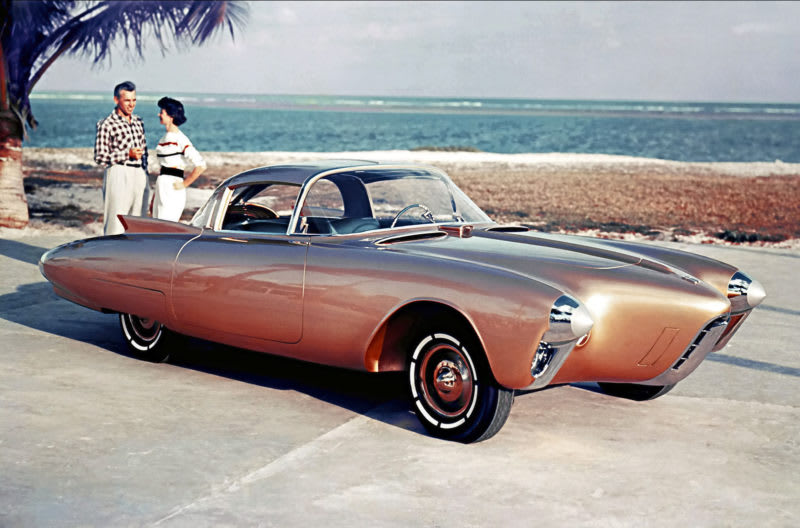
In car terms, this resulted in some of the most weird and wonderful concept cars arriving, beginning in the 1970s and continuing throughout the following decades of the 80s and 90s.
But while the cars were whacky, the steering wheels hidden within the cockpit were frequently even more hair-brained. A particular style emerged, known as 'Retrofuturism', which blended old-fashioned designs with visions of the future. This meant that the typical circular steering wheel, a fixture of cars since day one, began to be ditched in favour of alternative styles. Some of the world's biggest manufacturers weighed in with their own funky takes on the classic wheel, often both genius and hideous in equal measure.
We highlight some of the strangest steering wheels ever to enter production below, many of which creations of some the biggest names in the industry. We'll leave it to you to decide which ones were the best, or worst, depending on your tastes!
Much like the designers of the 70s, we've also got one eye on the future of the steering wheel and have uncovered public patents submitted by the likes of Subaru and BMW in recent years, to try and get a glimpse of what we can expect from the next generation of steering wheels.
Maserati Boomerang / 1971
First revealed at the Turin Motor Show in 1971, the Maserati Boomerang certainly turned some heads. Many considered it to be legendary car designer Giorgetto Giugiaro’s most extreme creation. However, it was only once you got inside the cockpit that you truly understood what had caused such as sensation.
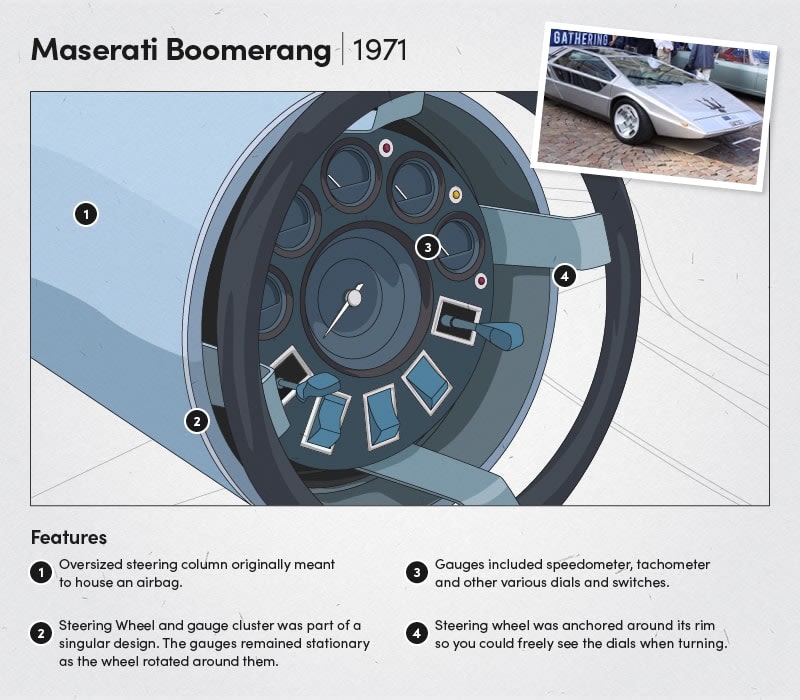
The car featured a revolutionary steering wheel design, yet to be seen in any form within the automotive industry. The wheel protruded from the centre console and housed all the dials you would expect to see on the dashboard within the wheel itself. Luckily, the steering wheel was anchored around its rim meaning you could still check how fast you were going when you went around corners.
Lancia Siblio / 1978
In 1978, Lancia presented the Stratos-based Sibilo to the world at the Turin Motor Show, the same place as the Maserati Boomerang was unveiled seven years previously. The car was very much designed to show what the ‘sports car of the future could look like’. Following the trend for supercars in the 1970s, the Bertone-inspired vehicle featured a wedge-shaped exterior which was considered extremely futuristic at the time.
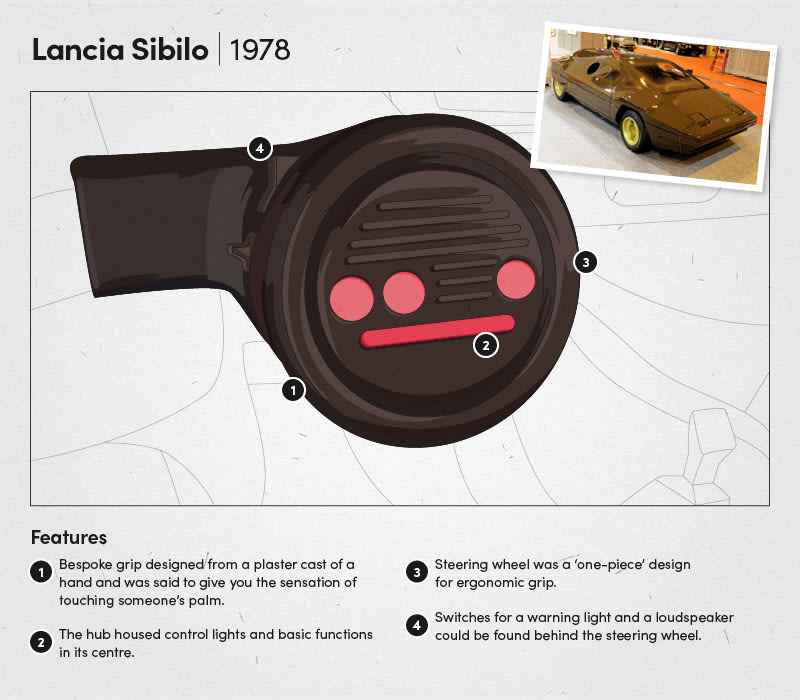
However, it was the steering wheel of the car that really got tongues wagging. It was designed to give the sensation of touching someone’s palm when driving and was an unorthodox ‘one-piece’ design for a more ergonomic grip. The majority of the car’s functions were found on or behind the steering wheel, leaving the rest of the interior looking a little sparse.
Citroen Karin / 1980
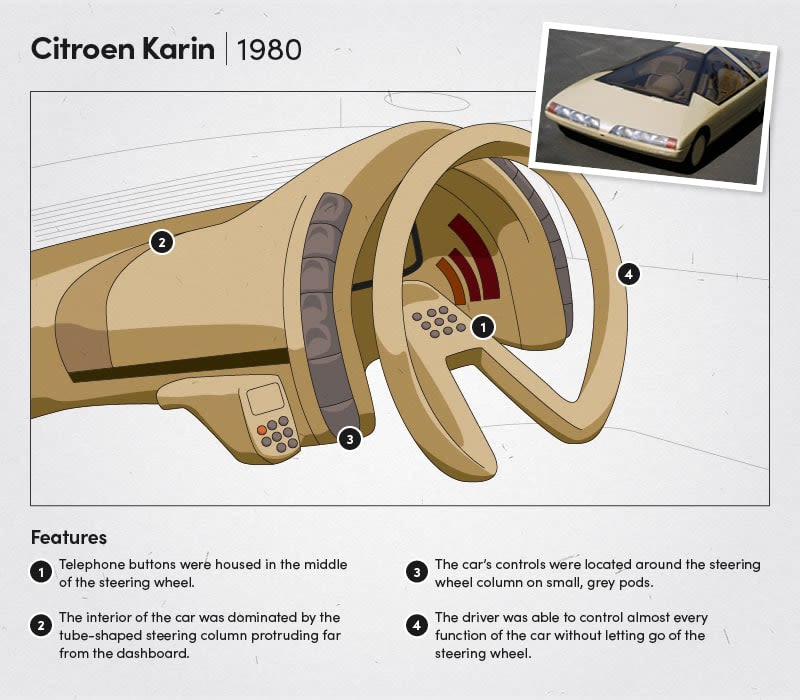
Since Citroen had no new car models to display in 1980, the French car manufacturer gave their designer Trevor Fiore free-reign to create a special concept car for the 1980 Paris Salon – and he did just that. The end product was a trapezoidal Karin. The car is also well known for having a centred, single seat in the front and two seats in the back. It wasn’t until you sat in the driver’s seat would you noticed the other peculiar thing about the Karin – the steering wheel.
The steering wheel, which featured a set of telephone buttons in the middle of the console, had a protruding tube-shaped steering column coming from the dashboard. It is said that the driver was able to control almost every function of the car without letting go of the steering wheel, something that particular modern-day cars have tried to mimic.
Oldsmobile Incas / 1986
This concept car, the 1986 Oldsmobile Incas, certainly got people talking when it was first released to the public 34 years ago. It featured a quad-turbo incline-4 engine, meaning unlike some concept cars, this one was fully functional. Sometimes compared to the car KITT from Knight Rider, the vehicle merged a futuristic appearance with 1980s interior and styling.
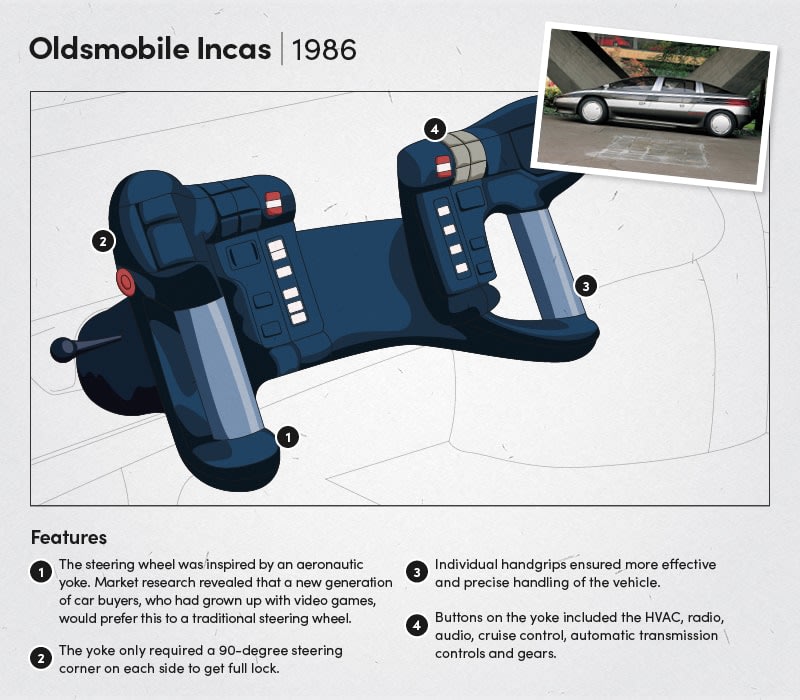
The steering wheel, or what could be more accurately described as a fighter-jet style yoke, was designed to improve the previse handling of the vehicle. Market research had shown that a new generation of car buyers, who had grown up with video games, would prefer this approach to a traditional steering wheel. The driver could control a whole host of car functions, including the radio, cruise control and gears.
BMW Z22 / 1999
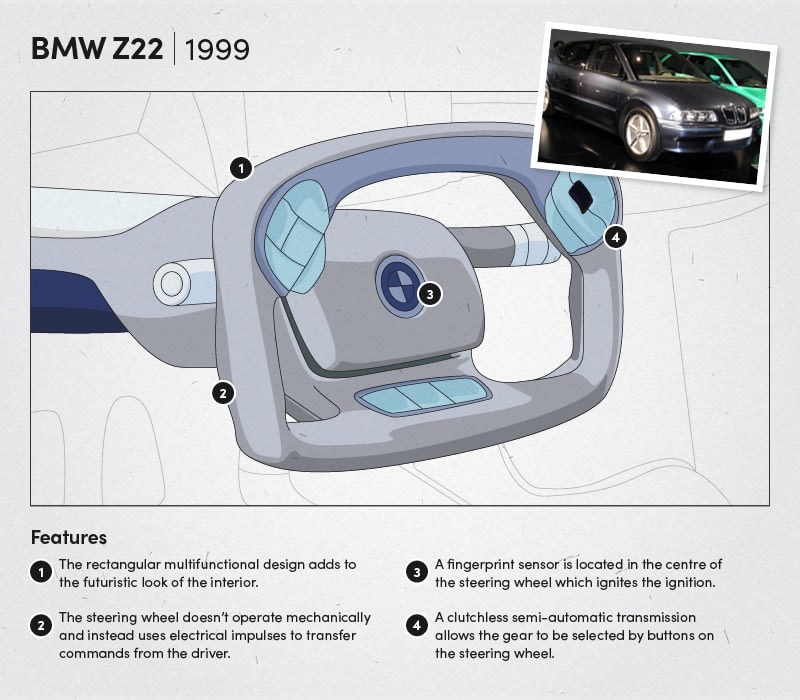
According to reporters, the BMW Z22 was something of a technological avalanche that managed to all find its way into one car. Is it said that the car features no less than 70 innovations and 61 registered patents within the exterior and interior.
A peek inside would show you a very futuristic looking steering wheel. Unlike other steering wheels of its time, it actually wasn’t operated mechanically. It instead used electrical impulses to transfer commands from the steering wheel to the car. It also allowed the gears of the car to be selected by buttons on the steering wheel, a precursor to the flappy paddle gearboxes included on the sporty cars of today. A fingerprint sensor was also included on the steering wheel, to ensure that only the person who owned the car could start it.
Honda EV-STER / 2011
The purpose of the Honda EV-STER was to "surprise people with just how cool it is” according to Honda’s lead designer, and it certainly did just that. The small roadster stole the show at the Tokyo Motor Show in 2011, due to its futuristic exterior design and the promise of low weight and cost. However, the most talked-about component was inside the cockpit of the car.
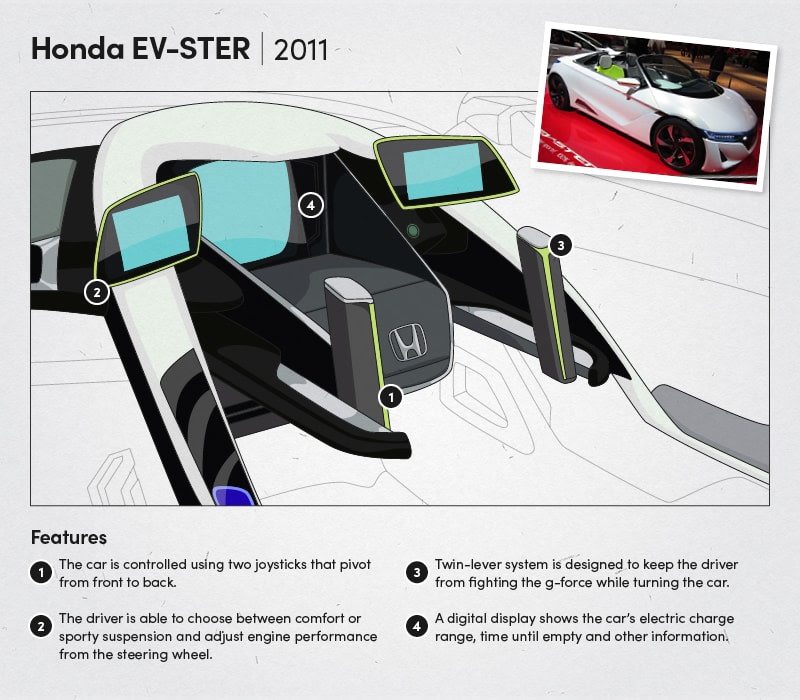
A typical steering wheel was replaced by two joysticks on the Honda EV-STER. Although this certainly adds a futuristic look, the redesign wasn’t a vanity project. The twin-level system is designed to keep the driver from fighting g-forces when turning around a corner. This is as the driver wouldn’t need to turn with the steering wheel, as it were, and could remain upright and stationary while pulling the levers back and forth. The driver is also able to view the electric charge range and other information on a heads up display.
Steering wheels: How will the future look?
Steering wheels are going to get increasingly weirder and more wonderful as technology progresses. However, we don’t think we’ll see a departure from the traditional steering wheel in favour of a fighter-jet style joysticks anytime soon, unfortunately. Our trawl of the patent library revealed that steering wheels are likely to keep their current form factor in the future, however, the technology within and surrounding them in the cockpit of the car will increase greatly.
Below are two of the most promising and exciting patents currently filed by some of the world’s biggest car brands that can tell us a lot about the future of the steering wheel.
Subaru / 2018
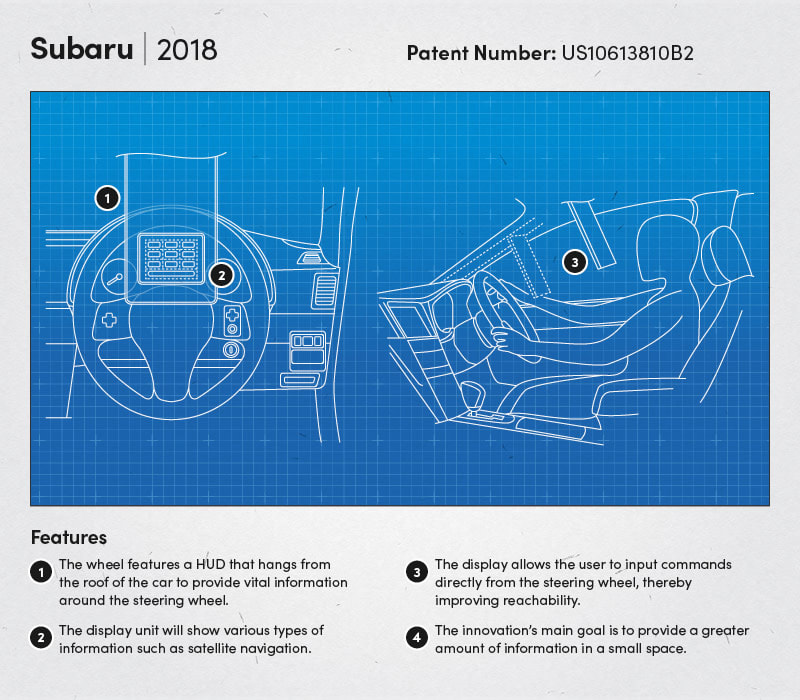
Subaru filed a patent back in 2018 showing a novel solution of how to increase the space on the dashboard, normally where the accelerometer and tachometer are housed, to be able to show more information. The patent shows a screen that hangs from the roof of the car in front of the driver. That screen will then use augmented reality to change what is being displayed on the dashboard, depending on the situation the driver finds themselves in.
Crucially, the driver is able to change what is being displayed without taking their hands off the steering wheel, meaning that the screen, in theory at least, should be safe to use on the road. It will be interesting to see if this technology catches on in the years to come and is widely adopted.
BMW / 2016

Of course, the history of the steering wheel might well be coming to an end in the next couple of decades – or at least how we currently know it. Autonomous vehicles will lessen the need for a steering wheel, as most of the time your car won’t require any human input. However, a steering wheel in some form will still be needed in case of emergencies, or the autonomous driving system in your car can’t handle a particular situation.
The patent filed by the BMW Group above shows their solution to this problem. The steering wheel houses a touchscreen within the centre, with the intention of offering the user a choice of manoeuvres that the car can perform in situations where the autonomous technology cannot yet make the choice for the driver, for example in traffic jams.
We at Select Car Leasing are certainly looking forward to the development of steering wheels, dashboards and cars in general in the years to come.
For more automotive content, make sure to bookmark the Select Car Leasing news page.
Ever wondered how much of your car comes from a spaceship? Our recently published research shows just how much NASA technology has worked its way into your car.















